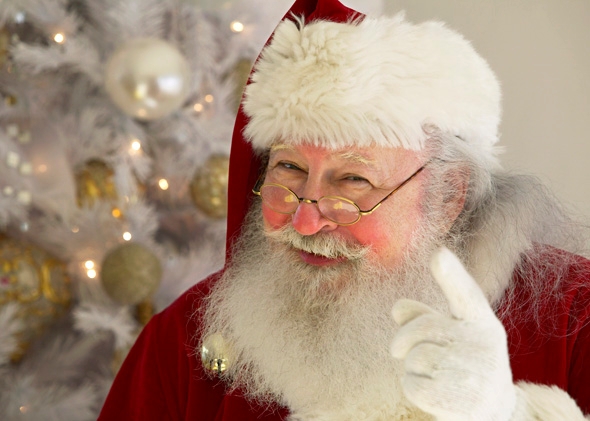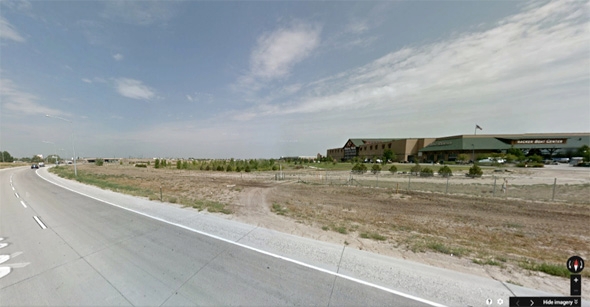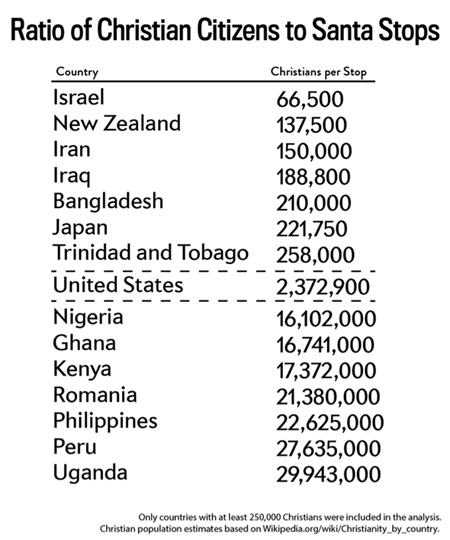Santa Claus Is Coming to Town, Eventually
His magic sleigh journey is highly inefficient. So we made him a better itinerary.

Photo by Digital Vision/Thinkstock
Santa Claus is meticulous—we know this. He spends the entire year preparing for a single evening. He assembles a comprehensive list of childhood behavior that is presumably hundreds of millions of entries long. He then checks the list not once, but twice.
You would think that this most punctilious of imaginary men would devote many hours of careful deliberation to the itinerary for his annual journey around the globe. But after examining the available data, I have concluded that Santa Clause comes to town by a very circuitous, inefficient route. By my calculations, Santa could take a route that is at least 12.5 percent shorter.
My analysis of Santa’s route is based on historic data from the North American Aerospace Defense Command, commonly known as NORAD, which since 1958 has been tracking his travels, presumably to prevent any unfortunate accidental scrambling of F-17s when the sleigh enters our airspace.
Twelve and a half percent may not sound like a lot, but it translates to more than 20,600 miles. Keep in mind that Rudolph was the ninth reindeer joining an existing team of eight—a 12.5 percent increase in reindeer power. Rudolph got an entire song.
Think of what Santa could do with the time he’d save: He could bring more Christmas cheer. He could check his list thrice. He could make more toys.
Below is an animation of Santa’s usual, inefficient path:

Admittedly, my attempt to improve on this circuitous route relies on a few assumptions. Santa’s movements are magic, and not well understood even by high-ranking officials at NORAD. For instance, what do the points on NORAD’s Santa map represent? In the past, the agency has sometimes referred to them as stops, and sometimes described them as merely places where Santa was “tracked.” Perhaps Santa has managed to evade radar between stops, but for the sake of my analysis, I have assumed that a team of nine caribou led by a man with a notoriously loud and distinctive laugh is easy enough for America’s military to track. I’m interpreting the points on NORAD’s map as stops.
I was also forced to rely on data from 2007, seven Christmases ago. I would have preferred more recent data. Unfortunately, the list of stops from more recent Christmases has been removed from NORAD’s website. I contacted NORAD directly and was told, bluntly, by a lieutenant colonel named Vanessa Shawyer, “I cannot send you a list of the complete route.” Maybe it’s a security issue.
So I was stuck with the older data. However, when I compared the 2007 data to the 2006 data, I found that the two trips were identical, down to the sixth decimal place of all latitude and longitude coordinates. This suggests to me that Santa’s path does not change much from year to year. The man’s been at this for centuries. He may well be set in his ways.
In all, according to NORAD’s 2007 data, Santa made 569 stops and traveled 178,899 miles. Of these stops, many were notable world cities such as Paris, Shanghai, and Chicago. However, some were less notable, including one stop NORAD describes as “I-270.”

Still via Google Earth
It’s unclear what Santa was doing on the side of I-270. The exact location is just outside Denver, near a strip mall. One of the buildings visible from the Google Street View of these mysterious coordinates is a Bass Pro Shop. Perhaps Santa was restocking his sleigh with rods and rifles for the outdoorsy children of the Mountain West?
The number of stops Santa makes varies widely by country and doesn’t seem to follow an obvious logic. In 2007, he made 19 stops in New Zealand, which has a Christian population of almost 2.5 million. He made just four stops in the Philippines, which has 36 times as many Christian residents. Had there been an epidemic of naughtiness in Manila that year?
Below I’ve listed the ratio for the countries with the highest number of stops based on their population, the lowest, and the United States for comparison.

Santa’s patterns are hard to figure. He ignores large swaths of Africa but makes frequent stops in the Middle East. (Does Santa supplement his reindeer-power with a fossil fuel– burning engine?) The United States was also the beneficiary of frequent stops—it received about twice as many stops as you might expect based on the number of Christmas-celebrating children—though not as many as Japan.
But who am I to second-guess Kris Kringle? In plotting a more efficient course for Santa, I assumed Santa would need to make the same stops he made in 2006 and 2007 this year, and that he needed to make all of his stops under cover of darkness. To find an improved path, I did some manual re-arranging before using a simulated annealing, a probabilistic method used to find the optimal value in complex problems. Because of the magnitude of the problem—it’s not easy delivering toys to all the world’s nice children—the path I found is in all likelihood not the most optimal path. But it is much closer to optimal than Santa’s old path. (If Santa wants the perfect path, he’s going to have to bring me at least a couple HP Z820s this year to crunch the numbers.)
Here’s my improved path for Santa:

I feel confident that this route would lead to a less weary, happier Santa. But I acknowledge that my improvements rely on a potentially faulty premise: that Santa wants to optimize his trip. Maybe his long trip is optimizing the Christmas spirit in a way my meager mathematical analysis can’t capture. (NORAD was no help on this point, either. Stacey Knott, the deputy chief of strategic outreach at NORAD, said, “NORAD can’t speak for Santa and we aren’t aware if Santa optimizes on travel efficiency or if he uses another metric.”) Or perhaps the explanation is more mundane: hundreds of millions of households equates to billions of cookies left out for Santa. Even Jolly Old St. Nick needs some time to digest.

No wrapping required! Give the gift of Slate Plus to another Slate fan in your life and they’ll receive all the benefits of membership: ad-free podcasts, bonus podcast segments, single-page articles, behind-the-scenes content, and so much more. Give Slate Plus today.